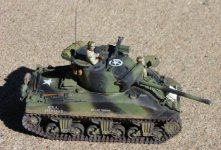Here are a couple of reference books;
"Code Name Swallow" from Mushroom Publications - a nice detailed work on the markings of the M4A1s at Alamein (available in the USA from
www.squadron.com)
"The New Breed" by Mike Starmer - a soon to be released title that is part of a large series on British armor, starting with the Mediterranean areas. see:
http://www.thefactorypublishing.com/on_sale_now.html
"Armor Camouflage and Markings, North Africa 1940-43" by George Bradford. This was published back in the 1970's but still shows up at reasonable prices on used book shelves. This covers British, German, Italian and US military vehicles. This was the first book to show the geometric symbols used by the US 1st Armored Division in Tunisia.
These boks might help the boys make a nice model.
Some general features of a Sherman for the British or US in North Africa;
Type: M4A1 (the cast hull Sherman with radial engine)
Features: early hull with direct-vision ports for the driver and hull gunner, early narrow gun shield for the 75mm gun, three-piece transmission cover, and all of the suspension bogies were the very early type that was the same as used on the M3 Medium ("Lee" or "Grant" types). Track was plain rubber block type.
Note: the British did not always use the .50 caliber Browning machine gun on the turret roof and they applied their own pattern dust shields to many of the Shermans, as well as small racks on the right front fender for the British 4-gallon petrol cans. Many of the British Shermans had a mounting rail near the fenders that was often used for personal equipment.
Most of the US Shermans in Tunisia were the same basic model. The US tankers didn't seem to carry quite as much personal equipment outside the tank as one would see later in Europe. The tanks were pretty much unchanged since they left the factory. Some of the US M4A1s had the first version of the suspension bogie with the trailing arm for the return roller and some did not have the direct-vision slots in front.
Gary



